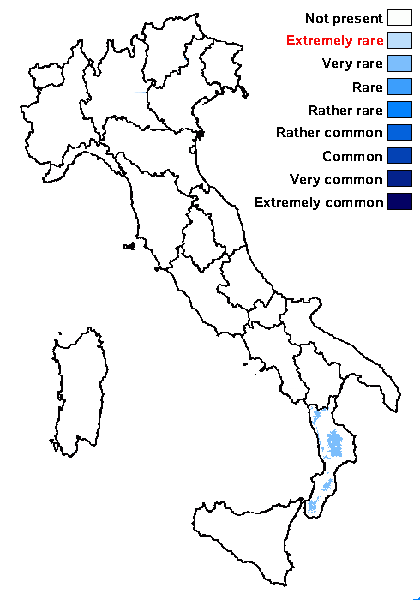Fuscidea praeruptorum (Du Rietz & H. Magn.) V. Wirth & Vězda
in Wirth, Beitr. naturk. Forsch. Südwestdeutschl., 31: 92, 1972. Basionym: Lecidea praeruptorum Du Rietz & H. Magn. in Du Rietz - Akad. Abhandl.: 164, 1921.
Synonyms:
Distribution: S - Cal (Puntillo 1996).
Description: Thallus crustose, episubstratic, pale to dark greenish brown (turning pink in the herbarium), areolate or unevenly verrucose, sorediate, delimited by a black prothallus; areoles rounded, convex-tuberculate, up to 0.4(-0.5) mm wide, contiguous to discrete, often thin, with an uneven surface; soralia punctiform, rounded, 0.2-0.5 mm across, at first pale green, ochre- or cream-coloured, soon turning brownish and more or less confluent. Medulla white, I-. Apothecia very rare, lecideine, 0.7-1(-1.5) mm across, sessile, black, with a flat to slightly convex disc and a thin proper margin. Proper exciple brown in outer part, paler within; epithecium brown; hymenium colourless or rarely pale brown, c. 100 μm high, I-; paraphyses 1.5-2 μm thick at mid-level, simple or sparingly branched, easily made free in K, the apical cells clavate, up to 4 μm wide; hypothecium colourless. Asci 8-spored, clavate, with a thin external and internal K/I+ dark blue cap surrounded by a thick K/I+ pale blue apical cap, and with a K/I- apical tube in tholus, Fuscidea-type. Ascospores 1-celled, hyaline, kidney-shaped, 9-12 x 3-5 μm. Photobiont chlorococcoid. Spot tests: soralia K+ yellow, C+ red, KC+ red, P+ yellow, UV+ faintly yellow-orange. Chemistry: medulla and soralia with alectorialic acid.Note: a mainly western species of steeply inclined to rain-sheltered surfaces of hard siliceous rocks in cold-humid situations, more rarely occurring also on bark; overlooked in Italy, certainly present in the Alps, but never common.
Growth form: Crustose
Substrata: rocks
Photobiont: green algae other than Trentepohlia
Reproductive strategy: mainly asexual, by soredia, or soredia-like structures (e.g. blastidia)
Most common in areas with a humid-warm climate (e.g. most of Tyrrenian Italy)
In underhangs rarely wetted by rain
Commonnes-rarity: (info)
Alpine belt: absent
Subalpine belt: extremely rare
Oromediterranean belt: absent
Montane belt: very rare
Submediterranean belt: absent
Padanian area: absent
Humid submediterranean belt: absent
Humid mediterranean belt: absent
Dry mediterranean belt: absent

Predictive model
Herbarium samples
Growth form: Crustose
Substrata: rocks
Photobiont: green algae other than Trentepohlia
Reproductive strategy: mainly asexual, by soredia, or soredia-like structures (e.g. blastidia)
Most common in areas with a humid-warm climate (e.g. most of Tyrrenian Italy)
In underhangs rarely wetted by rain
Commonnes-rarity: (info)
Alpine belt: absent
Subalpine belt: extremely rare
Oromediterranean belt: absent
Montane belt: very rare
Submediterranean belt: absent
Padanian area: absent
Humid submediterranean belt: absent
Humid mediterranean belt: absent
Dry mediterranean belt: absent

Predictive model
| Herbarium samples |
 Index Fungorum
Index Fungorum
 GBIF
GBIF


